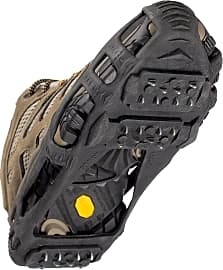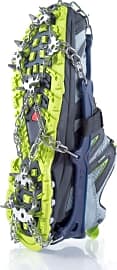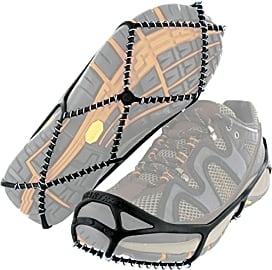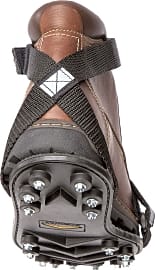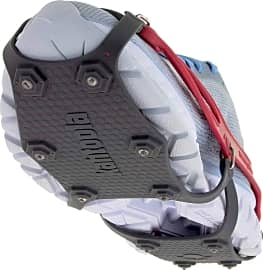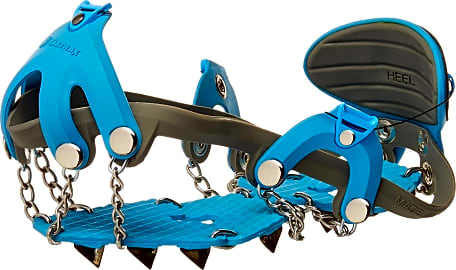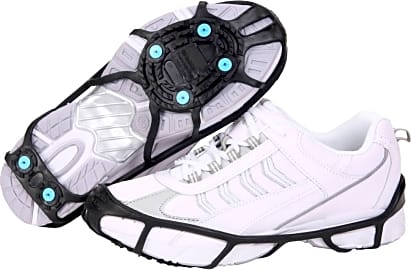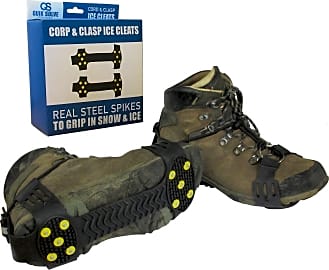The 10 Best Ice Traction Cleats

This wiki has been updated 38 times since it was first published in October of 2016. Just as it makes sense to add chains to your tires in snowy or icy conditions, it's a good idea to add some extra tread to your feet so that you don't slip and fall when walking in similar weather. The ice traction cleats we've listed here are less intense than the crampons you'd want for technical climbs, but they provide excellent stability for a wide range of everyday uses on slick surfaces. When users buy our independently chosen editorial selections, we may earn commissions to help fund the Wiki.
Editor's Notes
October 19, 2020:
There are lots of options for traction cleats out there, and selecting the right set will depend on whether you're looking to continue your jogging regimen during the winter, keep your hiking boots from sliding on icy trails, or just get some more stability while shoveling snow. In making the latest updates to our list, we've tried to ensure a good mix of all-around options and purpose-built specialty items.
Our most intriguing new cleats are the ICETrekkers Diamond Grip, which feature pointed beads mounted along sturdy steel cables, creating a natural rotation that helps clear away snowpack and grime as you move. This innovative grip system is great for most light to moderate conditions, and it's low-profile enough to remain comfortable on pavement and concrete.
For an aggressive option better suited to deep snowdrifts and sheer ice sheets, we've also added the Kahtoola MICROspikes, a flexible slip-on set sporting large teeth and a snug, durable harness. There are a number of similar heavy-duty options out there, but none that are so consistently praised by gear testers for their reliability, convenience, and sheer toughness. The Hillsound Trail Crampon Ultra come the closest, thanks to some nifty features that the MICROspikes lack; the most notable of these is a spike pattern that offers side-to-side as well as back-and-forth slip resistance. These are an upgrade of the older Hillsound Trail Crampons, which we removed from the list to make room for the new and improved version.
Another common cleat style makes use of small removable studs, which can be easily replaced when they've worn down. Unfortunately, customer feedback suggests that many models of this kind don't hold the inserts securely enough, causing them to pop out while in use. We decided to remove the OuterStar Ice & Snow Grips, and significantly downgrade the Quik Solve Walking Grip Spikes, based on the frequency with which reviewers mentioned this issue. Fortunately, the Stabilicers Maxx Original appear to be much less prone to this problem.
The last change we want to highlight is the addition of the Kahtoola NANOspikes, which are specifically designed to offer stability to cold-weather runners. Their wear-resistant carbide tungsten studs provide great grip on ice, and their low profile and shock-absorbing plates will help enhance comfort along your route.
Winter adventure enthusiasts might also want to look at our reviews of the top snowshoes or four-season tents. We also look at everyday cold-weather gear like down jackets and neck gaiters.
Sifting Through A Horde Of Options
Spiked cleats are probably the most aggressive option available.
Nobody likes to slip and fall. It’s embarrassing, it’s painful, and your clothes often end up stained or torn. The prospect of slipping and falling on the ice, however, takes that risk to another level. If you’re not prepared to walk on this slick surface, slipping is almost a guaranteed. And if the ice you fall on isn’t thick enough, there’s a good chance you’ll end up submerged in freezing water — not a situation you want to find yourself in, even if you’re an Olympic swimmer.
Ice cleats are similar to crampons, which are a more heavy-duty footwear attachment typically used for traction in ice climbing. With cleats, the first thing you should determine is which style best suits the activities in which you plan to participate. That search begins at the bottom: seek out soles with maximum grip.
Spiked cleats are probably the most aggressive option available. These penetrate into the ice to provide reliable traction. Cleats with carbon steel spikes will be the most affordable, but tungsten carbide spikes are more durable and will likely last much longer. Neither option is particularly versatile, as you’ll always have to remove spiked cleats when you encounter an ice-free surface.
Many brands feature screws (or studs) on the bottom for grip. Usually, these models are highly functional and easy to put on and take off. You can choose between replaceable and non-replaceable studs; while not as comfortable, the former will extend the life of your cleats, whereas you will need a completely new pair once a model with non-replaceable studs wears out. They tend to be more comfortable, though, so it really comes down to personal preference.
In certain situations, heel-only ice traction attachments are preferable. For example, if you frequently move from the outdoors to the cab of a vehicle, this versatile design leaves the front of your footwear free to connect with the pedal of your car or truck. You can also consider transitional cleats, which are recessed to the point where the sole’s rubber will connect with bare surfaces, but also feature low-profile studs with just enough length to grip snow and ice.
One Of Many Components To Ice Safety
Tens of thousands of workers in the northern U.S. and Canada suffer injuries each year due to trips and falls associated with ice. A lack of firm-gripping footwear is undoubtedly the cause of some of these incidents, but plenty of other factors play a role, as well. It boils down to preparation and sensible decision-making. For example, you can equip your vehicle with SUV snow chains to help prevent it from swerving in the snow, but if you drive recklessly and get stuck in a giant snow bank, what was the point?
Some believe polyurethane soles provide more grip than synthetic, nitrile and natural rubbers.
One thing you can do is learn to recognize when the ice you’ve encountered is old, and therefore weaker, than newly-formed ice. If it looks like it may be partially thawed, there’s a good chance it won’t support your weight properly, even with cleats on. This means you’ll be at risk of losing your balance. Additionally, though it may seem counterintuitive, the insulating properties of snow slow down the freezing process of ice. So, given the choice, you probably want to walk or jog on naked ice instead of snow-covered ice.
In addition to the style, a debate exists over which material is superior for your cleats. Since it’s so dependent on the specific situation, it really is a tough call. Some believe polyurethane soles provide more grip than synthetic, nitrile and natural rubbers. Others, who aren’t sold on polyurethane, swear by the flexibility and durability of those other materials. At the end of the day, variables such as air temperature, surface texture, and the prevalence of external substances that may have spilled onto the ice all matter when it comes to safety.
A final note: please, before you partake in any activity on or near ice where you aren’t sure of its thickness or the depth of any water below, educate yourself on the dangers of thin ice and how to recognize them. And lastly, avoid alcohol when you’re on the ice (for obvious reasons).
A Brief History Of Ice Traction Cleats
Today, tons of workers, athletes, and outdoor adventurists regularly wear personal ice traction gear all over the world. Historically, however, military personnel from mountainous regions and the Arctic were the earliest adopters of ice cleats. As you can imagine, those classic traction devices looked far different than their modern counterparts.
As you can imagine, those classic traction devices looked far different than their modern counterparts.
An early inventor first filed a patent for ice cleats in 1873, at which point the device was essentially a grooved plate with built-in spikes that were attached with pins. A cobbler or shoemaker had to create it, which meant that only the wealthy could afford it. Designers filed dozens of patents well into the 20th century, but it wasn’t until the 1960s and 1970s that the functionality of these items began to modernize.
The new models were less expensive, more comfortable, and easy to slide over your shoes. Winter sport athletes and emergency crews in cold-weather areas began using them. During the 1990s, designers used hardened stainless steel and stretchy plastics to make them more resilient. More companies selling ice cleats began to appear. Eventually, they became very popular in niche markets like winter jogging and ice fishing, and in places like Alaska and northern Canada.
Today, many ice cleats are built with thermoplastic elastomers (TPE), which help the cleats maintain elasticity in absolutely frigid temperatures. Other options are supremely affordable, designed to be used a few times and then discarded.



